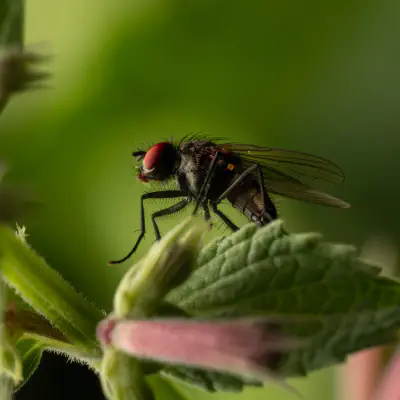Lesser House Flies and Allies
Lat. “Fanniidae“ The Fanniidae are a small (285 species in four genera) group of true flies largely confined to the Holarctic and temperate Neotropical ecozones; there are 11 Afrotropical species, 29 Oriental, and 14 Australasian.
Hierarchy Identifying characteristics The Fanniidae were once a subfamily of Muscidae from which they may be distinguished by:
A (strictly) dorsal bristle is on the hind tibia below the middle and in addition to the dorsal preapical.
The axillary vein is strongly curved towards the wingtip, so if extended, the axillary and anal veins would meet before reaching the wing tip.
In males, the middle tibia has an erect pubescence beneath; in females, the frontalia is without crossed bristles, the frontal orbits are broad, and convex towards median line of frons, and two pairs of strong upper orbital bristles are present, with the anterior pair turned outwards.
External links Family description and image Archived 2007-05-04 at the Wayback Machine
Picture Archived 2007-10-10 at the Wayback Machine
The Types of Fanniidae and Muscidae (Diptera) in the Museum für Naturkunde, Humboldt-Universität zu Berlin, Germany
Ancestry Graph %%{
init: {
'theme': 'base',
'themeVariables': {
'primaryColor': '#83a09c',
'primaryTextColor': '#212d2b',
'primaryBorderColor': '#fff',
'lineColor': '#fff',
'secondaryColor': '#006100',
'tertiaryColor': '#fff'
}
}
}%%
flowchart LR
classDef active fill:#fff
arthropods("phylum: Arthropods"):::active
arthropods-->insects("class: Insects"):::active
insects-->brachyceran-flies("suborder: Brachyceran Flies"):::active
brachyceran-flies-.->bee-flies("family: Bee Flies")
brachyceran-flies-.->blow-flies("family: Blow Flies")
brachyceran-flies-.->dance-flies("family: Dance Flies")
brachyceran-flies-.->dung-flies("family: Dung Flies")
brachyceran-flies-.->flesh-flies-and-satellite-flies("family: Flesh Flies and Satellite Flies")
brachyceran-flies-.->grass-flies("family: Grass Flies")
brachyceran-flies-.->heleomyzid-flies("family: Heleomyzid Flies")
brachyceran-flies-.->house-flies-and-allies("family: House Flies and Allies")
brachyceran-flies-.->hover-flies("family: Hover Flies")
brachyceran-flies==>lesser-house-flies-and-allies("family: Lesser House Flies and Allies"):::active
brachyceran-flies-.->locust-blowfly(["species: Locust Blowfly"])
brachyceran-flies-.->lonchoptera("genus: Lonchoptera")
brachyceran-flies-.->polleniidae("family: Polleniidae")
brachyceran-flies-.->root-maggot-flies("family: Root-maggot Flies")
brachyceran-flies-.->snipe-flies("family: Snipe Flies")
brachyceran-flies-.->soldier-flies("family: Soldier Flies")
brachyceran-flies-.->stiletto-flies("family: Stiletto Flies")
brachyceran-flies-.->tachinid-flies("family: Tachinid Flies")
brachyceran-flies-.->thick-headed-flies("family: Thick-headed Flies")
brachyceran-flies-.->woodlouse-flies("family: Woodlouse Flies")
click bee-flies href "/en/catalogue/arthropods/insects/brachyceran-flies/bee-flies/"
click blow-flies href "/en/catalogue/arthropods/insects/brachyceran-flies/blow-flies/"
click dance-flies href "/en/catalogue/arthropods/insects/brachyceran-flies/dance-flies/"
click dung-flies href "/en/catalogue/arthropods/insects/brachyceran-flies/dung-flies/"
click flesh-flies-and-satellite-flies href "/en/catalogue/arthropods/insects/brachyceran-flies/flesh-flies-and-satellite-flies/"
click grass-flies href "/en/catalogue/arthropods/insects/brachyceran-flies/grass-flies/"
click heleomyzid-flies href "/en/catalogue/arthropods/insects/brachyceran-flies/heleomyzid-flies/"
click house-flies-and-allies href "/en/catalogue/arthropods/insects/brachyceran-flies/house-flies-and-allies/"
click hover-flies href "/en/catalogue/arthropods/insects/brachyceran-flies/hover-flies/"
click lesser-house-flies-and-allies href "/en/catalogue/arthropods/insects/brachyceran-flies/lesser-house-flies-and-allies/"
click locust-blowfly href "/en/catalogue/arthropods/insects/brachyceran-flies/locust-blowfly/"
click lonchoptera href "/en/catalogue/arthropods/insects/brachyceran-flies/lonchoptera/"
click polleniidae href "/en/catalogue/arthropods/insects/brachyceran-flies/polleniidae/"
click root-maggot-flies href "/en/catalogue/arthropods/insects/brachyceran-flies/root-maggot-flies/"
click snipe-flies href "/en/catalogue/arthropods/insects/brachyceran-flies/snipe-flies/"
click soldier-flies href "/en/catalogue/arthropods/insects/brachyceran-flies/soldier-flies/"
click stiletto-flies href "/en/catalogue/arthropods/insects/brachyceran-flies/stiletto-flies/"
click tachinid-flies href "/en/catalogue/arthropods/insects/brachyceran-flies/tachinid-flies/"
click thick-headed-flies href "/en/catalogue/arthropods/insects/brachyceran-flies/thick-headed-flies/"
click woodlouse-flies href "/en/catalogue/arthropods/insects/brachyceran-flies/woodlouse-flies/"
click arthropods href "/en/catalogue/arthropods/"
click insects href "/en/catalogue/arthropods/insects/"
click brachyceran-flies href "/en/catalogue/arthropods/insects/brachyceran-flies/"
Further Information
„Lesser House Flies and Allies“ on wikipedia.org
„Lesser House Flies and Allies“ on iNaturalist.org
Copyright 



